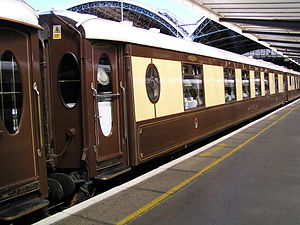Belmond British Pullman
 |
|
| Overview | |
|---|---|
| Franchise(s) | Railtour Operator |
| Fleet size | 14 rail carriages |
| Parent company | Belmond |
| Website | www.belmond.com |
Belmond British Pullman is a private luxury train that operates day and weekend journeys around Britain and also conveys passengers of the Venice Simplon-Orient-Express train, or VSOE, between London and Folkestone, as part of their journey to Venice and other European cities.
The train service was founded by James Sherwood of Kentucky, USA, in 1982. It is currently owned by Belmond Ltd. Belmond operates 45 luxury hotels, restaurants, tourist trains and river cruises in 24 countries.
Belmond British Pullman journeys operate mainly out of London Victoria station with visits to places of interest in southern Britain such as castles, country houses, cities, sporting occasions and events including the Grand National and Goodwood Revival. There are also weekend journeys to Cornwall, with overnight accommodation in hotels, and non-stop round trips with lunch, afternoon tea and dinner served on board. Elaborate dining is included in every journey.
While Belmond British Pullman operates mainly around London it has a sister train, Belmond Northern Belle, that operates mainly around northern Britain, offering journeys of a similar style.
Belmond British Pullman consists of Pullman coaches dating from the 1920s to 1950s. They were bought and restored between 1977 and 1982 and modern facilities such as electric heating and toughened glass installed. Original fittings such brass luggage racks were restored and furnishings sympathetic to the period, such as Art deco-style table lamps and armchairs, added. The carriage interiors are lined with wooden panels decorated with marquetry, which were restored by A Dunn and Son, a family firm that dates from 1895 and which created some of the originals.
Many of the carriages were part of the former Brighton Belle and were used to convey royalty. Although the records of the Pullman Car Company were destroyed in a World War II bombing raid, it has been possible to trace the history of the carriages, as detailed on plaques in each one.
...
Wikipedia

